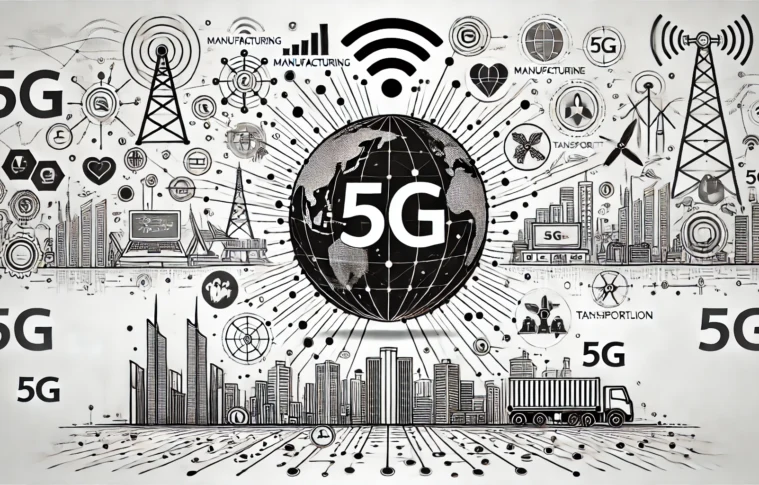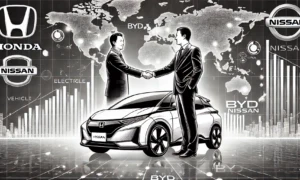The rollout of 5G mobile networks is poised to be one of the most transformative technological shifts of the next decade, fundamentally reshaping industries, driving innovation, and altering the way businesses operate. As the US and China lead the way in deploying this next-generation network, the potential for 5G to revolutionize business operations has become clearer. With an estimated market growth to $797.8 billion by 2030, the impact of 5G will not only accelerate digital transformation but also redefine the global economic landscape.
5G, the fifth generation of mobile network technology, offers unprecedented speeds, ultra-low latency, and the ability to support a massive number of devices and connections. This new infrastructure has the potential to catalyze a wide range of business innovations, from autonomous vehicles and smart cities to AI-powered applications and IoT ecosystems. By increasing connectivity, reducing communication delays, and enabling real-time data transfer, 5G will help businesses improve efficiency, productivity, and customer experiences like never before.
In this article, we will explore how 5G is expected to radically change business operations across various industries, examine the roles of the US and China in driving its global rollout, and highlight the key drivers and challenges surrounding the rapid adoption of 5G technology. As companies across the globe prepare for the arrival of this next-generation technology, understanding its business implications will be essential for staying ahead in the digital age.
What is 5G and Why Does it Matter?
5G is the next evolution in mobile networking, following 4G LTE, and promises to be much faster, more reliable, and versatile. While 4G networks could handle download speeds of up to 100 Mbps, 5G networks are designed to achieve download speeds of up to 10 Gbps, or 100 times faster than current 4G networks. The dramatic speed increase will enable instant data transfer, opening the door to more real-time business applications, and is expected to be a game-changer in industries reliant on high-speed communication and large-scale data processing.
Key features of 5G include:
- Higher Speeds: Download speeds of up to 10 Gbps, which will facilitate rapid transfer of massive data sets, video conferencing, and virtual collaboration.
- Ultra-Low Latency: Reduced latency as low as 1 millisecond will enable near-instantaneous communication between devices, which is critical for applications like autonomous vehicles, remote surgeries, and real-time gaming.
- Massive Device Connectivity: 5G can support up to 1 million devices per square kilometer, facilitating the growth of IoT (Internet of Things) and smart cities.
- Increased Reliability: 5G offers more stable connections, ensuring that businesses can rely on uninterrupted communication and data transfer, even in high-density environments.
This combination of speed, low latency, and device connectivity will open up entirely new business models and applications that were previously limited by the constraints of older mobile technologies.
5G’s Potential to Change Business Operations
The economic and operational implications of 5G are vast, and the technology is set to have a ripple effect across nearly every sector. Here’s how 5G is expected to impact business operations across key industries:
1. Manufacturing and Industry 4.0: A New Era of Automation
In the manufacturing sector, 5G will play a pivotal role in the realization of Industry 4.0—a new era of manufacturing that integrates physical production with cutting-edge technologies such as AI, machine learning, IoT, and robotics. With its ability to support real-time data analytics and massive device connectivity, 5G will allow businesses to create more efficient and intelligent supply chains, reduce downtime through predictive maintenance, and optimize production lines in ways that were once impossible.
For example, the automotive industry, already embracing automation in its factories, can benefit from 5G’s ability to connect thousands of devices simultaneously. Self-driving robots and augmented reality (AR) glasses for assembly line workers can communicate instantly with other machines, sensors, and systems, drastically improving efficiency and reducing errors.
2. Healthcare: Revolutionizing Patient Care
In the healthcare sector, 5G has the potential to completely transform patient care and medical operations. The ultra-low latency and high-speed capabilities of 5G will enable telemedicine to thrive, providing real-time video consultations, remote patient monitoring, and remote surgeries.
For example, surgeons will be able to perform procedures remotely with the aid of robotic tools connected to 5G networks, allowing them to operate on patients thousands of miles away with minimal delay. The IoT-enabled healthcare ecosystem will also benefit from real-time monitoring of medical devices, reducing the risk of failures and enabling more personalized care.
3. Retail: Enhancing Customer Experiences
In the retail industry, 5G will provide companies with the ability to offer highly personalized and immersive customer experiences. For example, AR and VR technologies, which require massive amounts of data and low latency to deliver seamless experiences, can now be deployed in retail environments. Customers will be able to virtually try on clothes or view 3D models of products from the comfort of their homes.
Moreover, the ability to track customer behavior in real time through IoT devices and smart sensors will allow retailers to deliver more personalized offers and promotions. Retailers can also streamline operations by integrating 5G with automated supply chains that adjust to changes in demand and inventory in real time.
4. Logistics and Transportation: Real-Time Tracking and Autonomous Vehicles
In logistics, 5G will enable real-time tracking of shipments, vehicles, and inventory through smart sensors and AI-powered analytics. The ability to track goods in real time will reduce inefficiencies, improve delivery times, and lower operational costs. Additionally, autonomous vehicles, which require fast and reliable communication to function safely, will become more feasible with the widespread rollout of 5G.
The use of 5G-enabled drones and robots for last-mile delivery is also on the horizon, allowing for faster and more efficient delivery of goods. Real-time data from traffic management systems and smart infrastructure will improve the efficiency of urban transportation, reducing congestion and environmental impact.
5. Smart Cities: Connecting the Urban Future
Perhaps one of the most ambitious applications of 5G is in the development of smart cities—urban areas that use IoT devices, sensors, and data analytics to improve the quality of life for residents. With 5G, cities can integrate various systems, from traffic management and waste collection to public safety and energy distribution, to create a more sustainable and efficient urban environment.
For example, smart traffic lights that respond in real time to traffic conditions will reduce congestion, while IoT-enabled streetlights can adjust their brightness based on foot traffic, improving energy efficiency. Additionally, 5G will support smart grids and renewable energy solutions, which can help cities manage their energy consumption and reduce their carbon footprint.
6. Financial Services: Enhancing Security and Efficiency
The financial services industry stands to benefit from 5G’s speed and reliability, especially when it comes to enabling real-time financial transactions and digital banking. The integration of blockchain, AI, and big data analytics with 5G will enhance the security and efficiency of financial services, from mobile payments to digital wallets.
Furthermore, 5G will enable faster and more secure online transactions, reducing fraud and improving trust between consumers and financial institutions. As digital currencies and decentralized finance (DeFi) platforms grow, 5G will be the backbone supporting their secure, instant transactions.
The US and China: Leading the 5G Rollout
While the benefits of 5G are clear, its global rollout is not without challenges. The United States and China are currently at the forefront of the 5G race, with both countries investing heavily in the infrastructure required to build out 5G networks. Each nation has different strategies and goals for deploying 5G, and their actions will have significant implications for businesses worldwide.
United States
In the US, the rollout of 5G has been driven by private telecommunications companies such as Verizon, AT&T, and T-Mobile, who have been racing to build out nationwide 5G infrastructure. The government has also been active in supporting the initiative, with Federal Communications Commission (FCC) programs aimed at allocating the 5G spectrum and promoting competition.
The US sees 5G as a key driver of economic growth and a way to maintain its leadership in global technology. However, challenges remain, including the high cost of infrastructure investment and regulatory hurdles that slow down deployment in rural areas.
China
China, on the other hand, has taken a more state-driven approach to 5G development. The Chinese government has committed to building the world’s largest 5G network and has already deployed over 1 million 5G base stations nationwide. Companies like Huawei and ZTE have played a central role in providing the infrastructure needed to support 5G, despite facing challenges in global markets due to security concerns.
China views 5G as a strategic priority, aiming to use the technology to advance industries like artificial intelligence, robotics, and big data. The Chinese government is also heavily investing in smart cities and autonomous vehicles, both of which will benefit from 5G connectivity.
Challenges in 5G Adoption
Despite the immense potential, the rollout of 5G faces several challenges:
- Infrastructure Costs: Building out the necessary infrastructure for 5G is a massive investment, particularly in rural areas that are harder to reach with high-speed broadband.
- Security Concerns: The reliance on 5G networks for critical business operations raises concerns over cybersecurity, especially regarding the potential for data breaches and hacking.
- Regulatory Hurdles: Governments must navigate complex regulatory landscapes to ensure the safe and fair rollout of 5G networks, while also ensuring that data privacy and national security are protected.
The Future: A World Transformed by 5G
The global transition to 5G is set to unlock immense value for businesses across every sector. With its potential to revolutionize communication, increase efficiency, and spur innovation, 5G will enable businesses to build more dynamic, connected, and intelligent systems.
The US and China will continue to lead the charge in 5G adoption, but businesses worldwide must prepare for the inevitable changes that 5G will bring. As global competition intensifies, those who successfully integrate 5G into their operations will gain a critical edge in the increasingly competitive digital economy.
Key Metrics: 5G Market Growth and Global Impact
| Metric | Value | Significance |
|---|---|---|
| Global 5G Market Size (2024) | $120 billion | Demonstrates the early stages of 5G adoption worldwide. |
| Projected 5G Market Value by 2030 | $797.8 billion | Reflects the exponential growth expected as 5G technology matures. |
| Global 5G Coverage (2024) | 50% of the world’s population | Indicates the accelerating rollout and global reach of 5G networks. |
| 5G-enabled IoT Devices (2030) | 50 billion+ | Highlights the massive increase in connected devices powered by 5G. |
| US 5G Adoption (2024) | 80% of urban areas | Indicates the rapid pace of 5G deployment in major US cities. |



